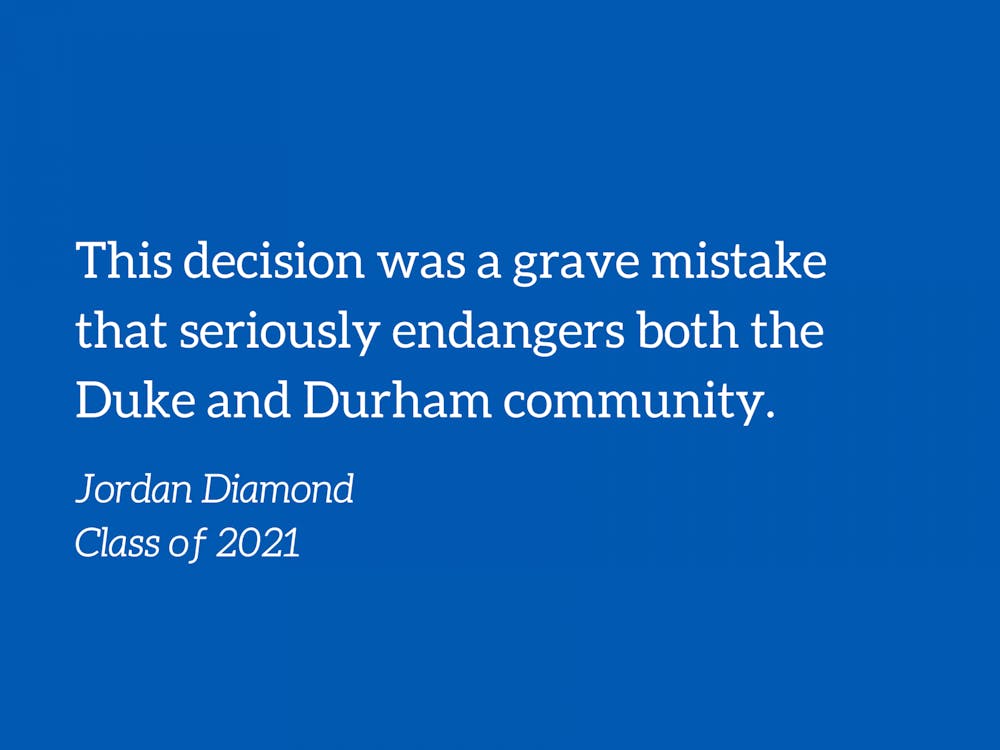Like most college students, I believe that the university’s primary mission is a noble one: to educate a youth hungry for knowledge and to lead the academic community by standing at the forefront of inquiry and discovery. Surely, Duke must take some risks at times to achieve these means to the furthest extent possible. But when Duke announced that they were planning to reopen (that cursed Egyptian amulet), I was seriously concerned about the implications of such a decision. It’s clear now that the public health detriments and mass chaos wreaked on our society outweigh the potential benefits of reopening. This decision was a grave mistake that seriously endangers both the Duke and Durham community.
By now, we’re all well aware of the origins of the bewitched artifact. Looted by a team of anthropologists during a 1920’s excavation of the Valley of the Kings, it stayed in the hands of a British financier and Egyptophile before being donated to the Nasher upon his death. When Duke archivists stumbled upon the object misplaced in a South American necklace collection, student activists began a call for its return to Cairo. Yet, entranced by the ocular design, subtle radiating aura and the curious notch in the jewelry (surely not larger than a few millimeters), the Nasher’s Director instead announced plans to investigate the item with a team of archaeological experts.
Some epidemiologists warned us over the summer that reopening it could have unintended consequences. But few administrators truly expected that the unfastened piece could spawn, in a blinding stream of light that the researchers all agreed seemed to encompass both ancient wisdom and untold auspices, four-foot-tall demons whose ungodly sight kills any unfortunate onlooker; nor that Durham would be haunted by a low-pitched, faint but always noticeable prolonged scream of agony for the past few weeks. (Scientists are still researching the correlation between this event and the moon suddenly turning a bright blood red color, seemingly increasing each night in size into its current shape unrecognizable to all who remember the image of our beloved satellite, but it’s likely that the two are related.) Given the ominous sudden bat infestation across Central North Carolina, it’s too late now for an apology—but Duke must recommit to ensuring the safety of workers and community members in a time of crisis like this one.
It’s worth pointing out that Duke’s decision was clearly influenced by financial concerns; in a bid to increase freshman matriculation, the University promised a normal campus experience amidst reopening (the amulet). Of course, these are abnormal times (similar crises have developed at many peer institutions which have also chosen to reopen relics and tombs), but Duke’s lack of transparency surrounding the developments in Durham led many to assume they would be safe from any necromanced wrath conjured via dark arts in a simple object obtained through colonial violence. What would this semester look like if Duke followed the guidance of its sorcery staff to keep students home as they repel the green slime that now entirely covers East campus?
Further, Duke has proven inept at communicating the ever-evolving contours of this calamity. Duke barely gave students a warning of their plans to reopen (the amulet), nor the Hellenic inscription beside it that warned of impending doom. One freshman, who asked to remain anonymous out of concern that the roaming packs of jackals may take political prisoners, explained that he “would have opted for online classes at home if I knew that ancient Greek tomb raiders had previously encountered this supernatural artifact, or that every day I would encounter the confounding scents of decaying embalments and mortal fear as I walk through campus.”
Duke’s required measures for students to remain distanced from the grotesque, hunch-gaited and gauzed undead have backfired spectacularly. I never guessed that first-years would throw an outdoor party on East Campus to “meet their new peers,” but administrators should have predicted that incoming students would need some social interaction after orientation was cancelled abruptly (all of New Student Programs staff disappeared in a plume of blue flame during a demonstration of alcohol portions). What happens when other orientalist fiction clichés suddenly come to life and enchant Durham? Does Duke have any plan in place for genie wishes gone awry, booby traps resulting from the retrieval of a golden idol from a lost temple, or any number of Conradian episodes that may emanate on campus?
What can we do now? First, Duke must bow to our new (ancient?) overlords. It is clear that the obelisk erected in place of the Chapel vests this campus’ power, and the cowards in the Allen Building would do well to get on its good side. Second, Duke needs to begin universal hieroglyph instruction—I, for one, can’t read any of the dietary restriction information in West Union when I head for my daily rations of barley, lentils, and Nile fish. Most importantly, we need to work together to protect our common safety. Duke has failed us and failed Durham by reopening (that cursed Egyptian amulet), so we need to donate to mutual aid projects (fighting the green sludge is a team effort), stay home as much as possible (or else beware the jackals), and work to return to normalcy with a lens toward justice (return the necklace to its tomb—don’t throw it in an active volcano!).
Jordan Diamond is a Trinity senior. His column, “diamond in the rough,” runs on alternate Wednesdays.
Get The Chronicle straight to your inbox
Signup for our weekly newsletter. Cancel at any time.

